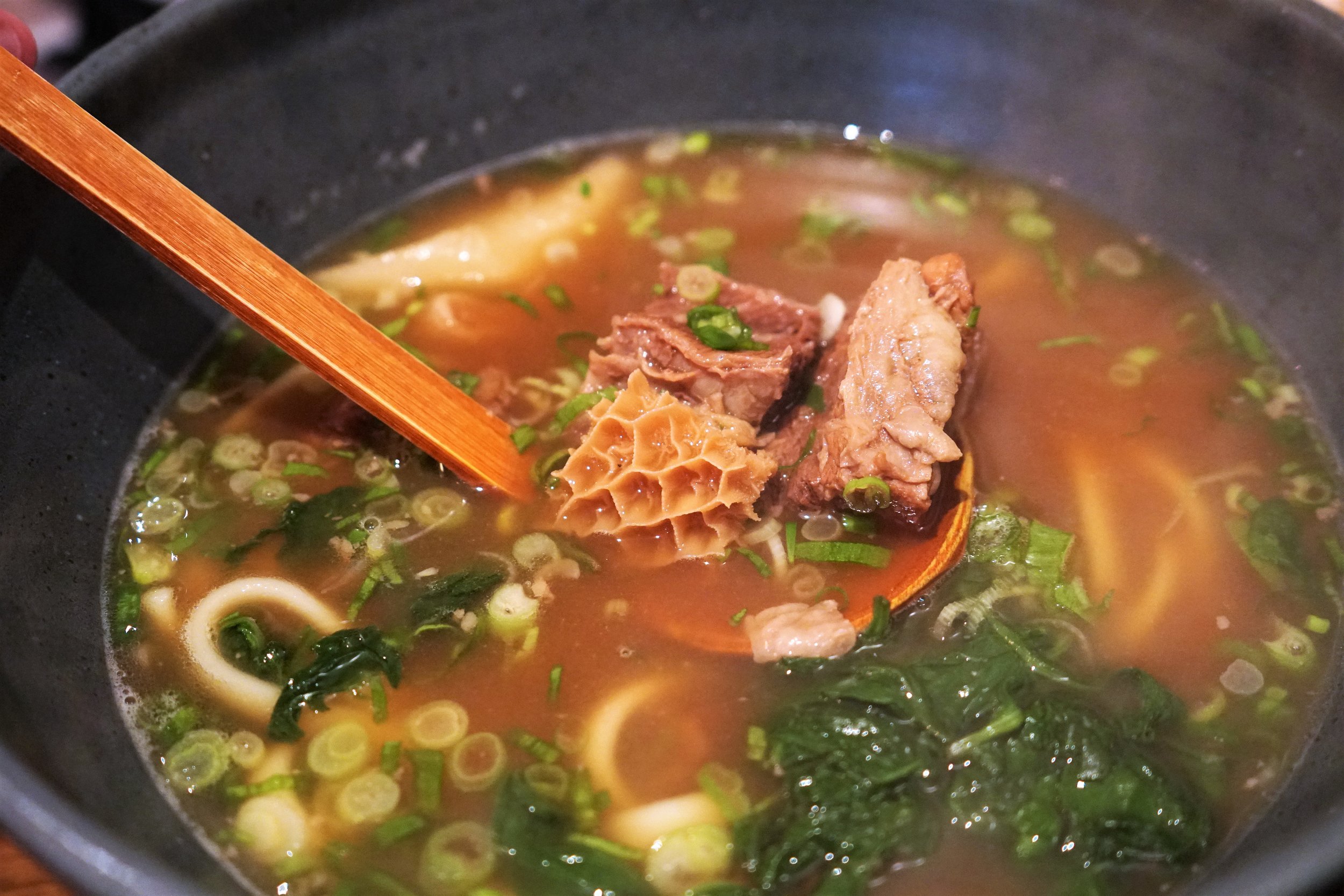Ngo Your Meal Battle Series: TsuruTonTan vs. Raku
Welcome to our first Ngo Your Meal Battle Series! I've never done this before so it's subject to change over time. But, some friends thought this might be interesting to add to the blog so... why not!
Today, we're going to face-off two formidable restaurants against each other. These duels are based primarily on the quality of food but also includes extraneous attributes, including ambiance, service, price, etc. Today, we're going to check out two udon specialists in New York City: TsuruTonTan and Raku.
Udon is one of Japan's most profound noodle dishes and is characterized by its thick wheat flour noodles. It can be served both hot or cold and the broth can differ from bowl to bowl.
A simple bowl of udon will contain a soup of dashi (cooking stock), soy sauce, and mirin (cooking wine). It can then be topped with a myriad of ingredients including, scallions, tempura, eggs, mushrooms, fish cakes, etc.
If you're interested in learning a bit more about this cool noodle, check out our udon guide.
Anyway, as I mentioned earlier, we'll focus on the quality of the food with an emphasis on the udon. First, we're going to describe a few key attributes and characteristics to score our udon.
Heat: Hot udon should be hot and cold udon should be cold. Simple enough! This will be graded Pass/Fail.
Mouthfeel: Smooth and slippery. This will be graded Pass/Fail.
Texture: Udon noodles should be cooked al dente - slightly chewy and bouncy, instead of soft and mushy.
Noodle Taste: To an extent, the noodles should carry the flavors of the broth. But, it should still maintain its own wheat flavor.
Broth Taste: In our udon guide, I described that there are two overarching styles of udon: Kansai and Kanto. In order to eliminate bias as much as possible, I'll be focusing on the quality of the flavor (e.g. salt levels, balance, etc.).
To me, these are the most important factors that make a bowl of udon great. Each of the above attributes will be scored from 0 to 5 (see below for rubric).
0 to .99: This is pretty bad
1 to 1.99: Below Average
2 to 2.99: OK
3 to 3.99: Good
4 to 4.49: Very Good
4.5 to 4.99: Excellent
Pass: No deductions.
Fail: Subtract .1 off the subscore for key attributes
Today, we'll battle the *Top Seller* TsuruTonTan Deluxe against the beefy Niku Udon at Raku. As seen above, the TsuruTonTan Deluxe is a mighty bowl of udon that includes Shrimp Tempura, Short Plate Beef, Chicken, Wakame Seaweed, and Egg.
Below, the Niku Udon weighs in with chunks of Beef Short Ribs and Honeycomb Tripe. At first glance, these two delicious bowls of udon are drool-worthy opponents. Let's go find out which bowl comes out on top.
After much deliberation, the grading for the key attributes are as follows:
| Characteristic | TsuruTonTan | Raku |
|---|---|---|
| Heat | Pass | Pass |
| Mouthfeel | Pass | Pass |
| Texture | 3.6 | 4.2 |
| Noodle Taste | 3.9 | 4.1 |
| Broth Taste | 3.9 | 3.9 |
| Subscore Avg. | 3.8 | 4.07 |
TsuruTonTan's noodles didn't feel al dente. They we're slightly mushy. Over time, it was a bit tiring eating their noodles. The taste was good though. By itself, TsuruTonTan's broth (less some of the ingredients) was also quite good.
Raku's noodles were very good in both texture and taste. But, to some people, the broth might be a bit too salty. It was still good though and I didn't think it was salty. Overall, Raku killed it when it came to the texture of the noodles.
Separately, I'd also like to score a few peripheral factors (see below):
| Characteristic | TsuruTonTan | Raku |
|---|---|---|
| Homemade? | Yes | Yes |
| Udon Bowl Size | Large | Large |
| Noodle Shape | Round, Long | Semi-Flat, Long |
| Restaurant Ambience | Spacious, Trendy | Comfortable, Minimalistic |
| Sound | Somewhat Loud | Moderate |
| Price (Lunch - Per Bowl) | $11 to $24 | $9 to $19 |
| Value | Good | Very Good |
And, finally, here are a few qualitative pros and cons:
| TsuruTonTan | Raku | |
|---|---|---|
| Pros | - Thick/Thin noodles available - Large serving of noodle available at no extra charge - Extensive seasonal menu |
- Smaller restaurant - Amazing, authentic appetizers (see Silver-Stripe Round Herring below) - $5 Sabazushi, pressed, pickled mackerel sushi (dinner only) - try Ishizuka's sushi without the whole omakase at Kura |
| Cons | - Menu seems a bit too distracted with uni, US wagyu, etc. (see wagyu sushi below) - Tempura in TsuruTonTan Deluxe was sub-par and soggy |
- Cash only |
Anyway, both TsuruTonTan and Raku have dank udon. But, today, the winner is RAKU. I inclined to visit both restaurants again to battle two other bowls of udon. Then, I'd be happy to revisit the scoring for this battle series :)
Hope you enjoyed this post! I liked writing it so there should be more to come. Feel free to comment below if you have any feedback.
TsuruTonTan: 21 E 16th St., New York, NY 10003
Raku: 342 E 6th St., New York, NY 10003





